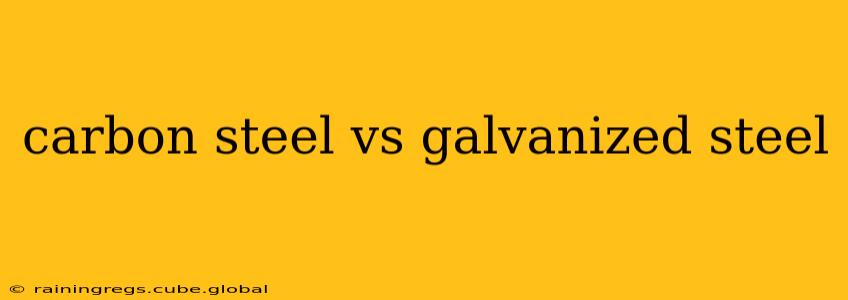Choosing between carbon steel and galvanized steel often depends on the specific application. Both are incredibly versatile materials used extensively in construction, manufacturing, and various other industries, but their properties differ significantly, leading to distinct advantages and disadvantages. This comprehensive guide will explore the key differences, helping you determine which steel is best suited for your needs.
What is Carbon Steel?
Carbon steel is an alloy of iron and carbon, with carbon content typically ranging from 0.05% to 2.1%. The carbon content directly influences its properties: higher carbon content generally means greater strength and hardness but reduced ductility (the ability to be deformed without fracturing). Carbon steel is known for its strength, weldability, and relatively low cost, making it a popular choice for numerous applications.
What is Galvanized Steel?
Galvanized steel is carbon steel that has been coated with a layer of zinc. This zinc coating provides exceptional corrosion resistance, significantly extending the lifespan of the steel, especially in outdoor or humid environments. The zinc acts as a sacrificial anode, protecting the underlying steel from rust even if the coating is scratched or damaged.
Carbon Steel vs. Galvanized Steel: Key Differences
Here's a table summarizing the key differences between carbon steel and galvanized steel:
| Feature | Carbon Steel | Galvanized Steel |
|---|---|---|
| Base Material | Iron and Carbon | Carbon Steel + Zinc Coating |
| Corrosion Resistance | Low | High |
| Strength | High (varies with carbon content) | Slightly Lower (due to coating) |
| Ductility | High (varies with carbon content) | Slightly Lower (due to coating) |
| Weldability | Good | Good (though precautions needed) |
| Cost | Relatively Low | Slightly Higher |
| Applications | Structures, machinery, tools | Fencing, roofing, automotive parts |
How Does the Galvanizing Process Affect the Steel's Properties?
The galvanizing process, typically hot-dip galvanizing, involves immersing the carbon steel in molten zinc. This creates a strong metallurgical bond between the zinc and the steel, resulting in a durable and protective coating. While the zinc coating slightly reduces the overall strength and ductility compared to bare carbon steel, this trade-off is often more than compensated for by the increased lifespan due to superior corrosion resistance.
Which Steel is Right for My Project? (Addressing common questions)
Here we address some frequently asked questions to further clarify the selection process:
What are the applications of carbon steel?
Carbon steel's high strength and weldability make it ideal for various applications including: structural components in buildings and bridges, automotive parts, machinery components, tools, and pipelines. The choice of specific carbon steel grade depends on the required strength and other properties.
What are the applications of galvanized steel?
The excellent corrosion resistance of galvanized steel makes it suitable for outdoor applications such as: roofing, fencing, guardrails, automotive body parts, and ductwork. It's also used in applications where extended lifespan is critical, even if strength is slightly less important.
Is galvanized steel more expensive than carbon steel?
Yes, galvanized steel is generally more expensive than carbon steel due to the added cost of the zinc coating and the galvanizing process. However, the extended lifespan and reduced maintenance often outweigh this initial cost difference, particularly in corrosive environments.
Can galvanized steel be welded?
Yes, galvanized steel can be welded, but precautions are necessary. The zinc coating can produce fumes that are harmful if inhaled, so proper ventilation and safety equipment are crucial. Special welding techniques may also be needed to ensure good weld quality.
Is carbon steel recyclable?
Yes, both carbon steel and galvanized steel are highly recyclable materials. Recycling steel saves energy and reduces the need for mining new resources.
By carefully considering the specific requirements of your project – including the need for corrosion resistance, strength, weldability, and budget – you can confidently choose between carbon steel and galvanized steel to achieve optimal results. Remember to consult with a materials specialist for complex applications.
